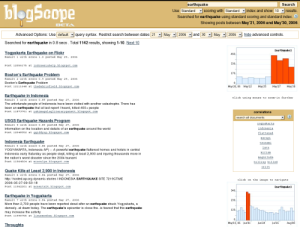Sunday, August 27, 2006
Launching BlogScope
Internet has provided a platform using which everyone can express his or her opinion to a wider audience. Millions of people from all around the world are using blogs for documenting their life; people write their experiences about everything, from movies to restaurants, and politics to personal life. This phenomenal popularity of blogs as media form has made blogosphere an invaluable source of information. But, it is not an easy task to find relevant and interesting content, as there are millions of blogs and a lot of content is repetitive and noisy. For past seven months, we have been working on how can we assist the user in his or her journey of exploration through blogosphere. As a result, we have developed BlogScope.

BlogScope is a knowledge discovery and analysis tool for blogosphere. To assist user find interesting information from large amount of text is blogosphere, BlogScope analysis engine offers tools like popularity curves, correlated terms, popularity bursts, and comparison curves. These tools can be used to track trends and temporal evolution of topics, investigate the relationship between keywords, or even for comparing apples with oranges. For bloggers, BlogScope offers some interesting tools like Summary Cloud. To know more read the about page. We also have a small 90 second flash movie demonstrating the system.
We are currently tracking over 4 million blogs with 25 million blog posts in our database. Number of posts is growing at a fast rate of hundred thousand per day. Codebase of BlogScope is also growing at an equivalently fast rate, and we plan to add many more cool features in future, so keep checking. We hope that you like it. And do send your feedback.
This is a flash demo of BlogScope and requires availability of flash player.
Last updated: 11th Sept, 2006.
Tuesday, August 08, 2006
java Exception - Unknown Source


When debugging my Java programs, reading through the exception stack trace I realized that many a times the line number in was not reported. Just the method name and file name with unknown source was reported. For example consider the following simple program compiled with build file as shown
//File: TestDebug.java
public class TestDebug {
public static void main(String[] args) {
((String)null).length();
}
}
<!-- build.xml --> <project name="TestProject" default="build" basedir="."> <target name="build"> <javac srcdir="." destdir="."/> </target> </project>
[nilesh^trinity]$ ant build
...
[nilesh^trinity]$ java TestDebug
Exception in thread "main" java.lang.NullPointerException
at TestDebug.main(Unknown Source)
After some investigation I found that ant omits debug information from compiled class by default. Hence producing exact line number in case of an error is not possible. The solution however is simple. I just modified my build file to turn debug on and to set debuglevel="lines,vars,source" under javac target in ant, and everything worked fine. Modified build file for above example will be:
<!-- build.xml --> <project name="TestProject" default="build" basedir="."> <target name="build"> <javac srcdir="." destdir="." debug="on" debuglevel="lines,vars,source" /> </target> </project>
Line numbers are now reported with the stack trace:
[nilesh^trinity]$ ant build
...
[nilesh^trinity]$ java TestDebug
Exception in thread "main" java.lang.NullPointerException
at TestDebug.main(TestDebug.java:4)



